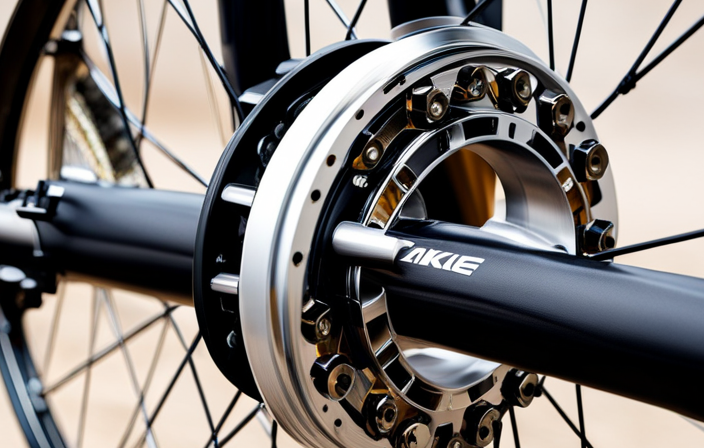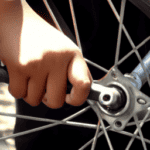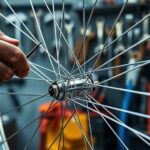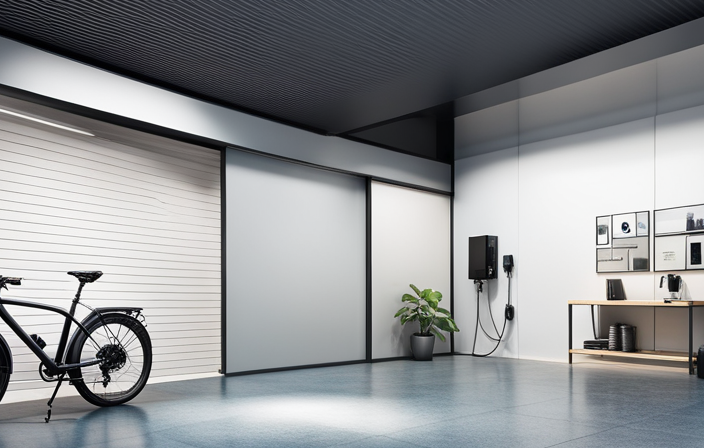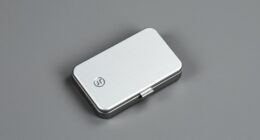So you’ve got yourself an electric hub bike wheel, huh? Well, let me tell you, lacing that bad boy is no walk in the park.
But fear not, my fellow wheel enthusiasts, because I’m here to guide you through the intricate process step by step.
With the right tools, a little patience, and a whole lot of precision, you’ll be lacing that wheel like a pro in no time.
So grab your spoke wrench and let’s get this wheel spinning!
Key Takeaways
- Lubricate the hub and rim before lacing the wheel for smoother lacing and improved performance.
- Use an online spoke calculator or consult a professional bike shop to determine the correct spoke length and pattern for your electric hub bike wheel.
- Take care when lacing the wheel to avoid crossing spokes incorrectly and to ensure even tightening of the spokes.
- After lacing the wheel, make gradual adjustments and recheck trueness using a spoke wrench and truing stand, paying attention to proper spoke tension and seating in the hub and rim.
Gather the Necessary Tools and Materials
You’ll need to gather the necessary tools and materials for lacing an electric hub bike wheel. Choosing the right tools is crucial for a successful lacing process.
You will need a spoke wrench, a spoke nipple driver, a truing stand, and a spoke tension meter. These tools will help you adjust the tension and alignment of the spokes, ensuring a properly laced wheel.
Understanding the different types of spokes is also important. There are various materials and gauges available, such as stainless steel and aluminum, each with their own strengths and weaknesses. Consider the type of riding you’ll be doing and the weight requirements of your bike when selecting the appropriate spokes.
Once you have gathered all the necessary tools and materials, you can move on to preparing the hub and rim for lacing, ensuring a solid foundation for your wheel.
Prepare the Hub and Rim for Lacing
To start, it’s important to ensure the hub and rim are properly prepared for lacing.
-
Lubricating the hub and rim for smoother lacing: Before starting the lacing process, apply a small amount of lubricant to the spoke holes on the hub and rim. This will help the spokes slide in more easily, reducing friction and making the lacing process smoother.
-
Importance of proper spoke hole alignment during wheel lacing: It is crucial to ensure that the spoke holes on the hub and rim are properly aligned before lacing. Misalignment can lead to uneven tension and a weak wheel. Carefully inspect the hub and rim, making sure that the spoke holes are in a straight line and properly aligned with each other.
-
Determine the spoke length and pattern: Once the hub and rim are prepared, the next step is to determine the appropriate spoke length and lacing pattern. This will depend on the specific hub and rim combination you are working with. By following the manufacturer’s guidelines or consulting a spoke length calculator, you can determine the correct length and pattern for your wheel.
Now, let’s move on to determining the spoke length and pattern.
Determine the Spoke Length and Pattern
Once the hub and rim are prepared, it’s important to determine the appropriate spoke length and lacing pattern for your specific setup. This step ensures optimal performance and durability of your electric hub bike wheel. To determine the spoke length, you can use an online spoke calculator or consult a professional bike shop. It’s crucial to measure the hub and rim accurately to obtain accurate results. Additionally, consider factors like spoke tensioning techniques and different spoke patterns for different riding styles. The spoke tensioning techniques, such as even tension or radial lacing, will impact the overall strength and stability of the wheel. Different spoke patterns, such as cross-lacing or radial lacing, provide varying levels of strength and flexibility. Once the spoke length and pattern are determined, you can start lacing the wheel, ensuring a secure and reliable construction.
Start Lacing the Wheel
Now that the hub and rim have been prepared, it’s time to begin lacing the wheel for optimal performance and durability.
As a beginner, there are a few important tips to keep in mind.
First, make sure to start with the correct spoke length and pattern determined in the previous step. This will ensure that the spokes fit properly and provide the necessary support for the wheel.
Next, avoid common mistakes such as crossing the spokes incorrectly or tightening them unevenly. These errors can lead to an imbalanced wheel and reduced performance.
By following the correct lacing pattern and tightening the spokes evenly, you will create a strong and stable wheel.
With the lacing complete, the next step is to adjust the spoke tension for a perfectly trued wheel.
Adjust the Spoke Tension
After lacing the wheel, it is important to adjust the tension of the spokes for optimal performance. Proper spoke tension is crucial in bike maintenance as it ensures a stable and durable wheel.
Here are three important factors to consider when adjusting spoke tension:
-
Even tension: Each spoke should have the same amount of tension to maintain balance and prevent wheel wobbling. Use a spoke tension meter to measure and adjust the tension accordingly.
-
Gradual adjustments: Avoid making sudden and drastic changes to the spoke tension. Instead, make small adjustments and recheck the wheel’s trueness after each adjustment to prevent over-tightening or loosening.
-
Spoke wind-up: When tightening the nipples, be cautious of spoke wind-up. This occurs when the spoke twists instead of the nipple turning. To prevent this, hold the spoke with a firm grip while turning the nipple.
Properly adjusting the spoke tension will lay the foundation for truing and centering the wheel in the next step.
True and Center the Wheel
To achieve a well-aligned and centered wheel, it is essential to true and center it by adjusting the spoke tension.
Wheel truing techniques play a crucial role in ensuring the wheel spins smoothly and evenly. The process involves identifying any lateral or radial deviations, and then making precise adjustments to the spoke tension accordingly.
It is important to use a spoke wrench to tighten or loosen the spokes in small increments, ensuring a gradual and controlled adjustment. Common mistakes in wheel truing include over-tightening or loosening the spokes too much, which can further misalign the wheel.
Additionally, not using a truing stand or a similar tool can make the process more challenging. By carefully following these techniques, you can achieve a properly trued and centered wheel, setting the foundation for a safe and efficient ride.
Now, let’s move on to the next step of finish lacing the wheel.
Finish Lacing the Wheel
You should complete the process of lacing the wheel to ensure its proper assembly. It is crucial to pay attention to the spoke tension during this step.
Maintaining proper spoke tension is important for the overall strength and durability of the wheel. Incorrect spoke tension can lead to a variety of issues, such as wheel wobbling, spokes breaking, or even wheel failure while riding. Therefore, it is essential to carefully tension each spoke to the appropriate level.
Additionally, there are some common mistakes to avoid when lacing a bike wheel. These include uneven spoke tension, crossing spokes incorrectly, or not properly seating the spokes in the hub and rim. By avoiding these mistakes and ensuring proper spoke tension, you can create a strong and reliable wheel.
Now, let’s move on to the next step and test the wheel for proper alignment and tension.
Test the Wheel for Proper Alignment and Tension
Check if the alignment and tension of the wheel are correct.
Proper wheel alignment is crucial for electric hub bikes as it affects the overall performance and safety of the ride. A misaligned wheel can cause handling issues and put unnecessary strain on the bike’s components.
To ensure proper alignment, use a ruler or a straight edge to check the distance between the rim and the brake pads on both sides. If the gaps are not equal, adjust the spokes accordingly until they are.
Additionally, wheel tension is another important factor to consider. Common issues with tension include loose spokes or uneven tension across the wheel. Check for any loose spokes and tighten them as needed. An evenly tensioned wheel provides better stability and durability.
Once the alignment and tension are correct, it is time to move on to the next step of installing the tire and tube.
Install the Tire and Tube
Start by positioning the tire and tube onto the rim. Make sure the tube is properly aligned with the valve hole on the rim.
Then, starting at the opposite side of the valve, push the tire onto the rim, working your way around. Use your hands or tire levers if necessary, being careful not to pinch the tube.
Once the tire is fully seated on the rim, inflate the tube slightly to give it shape.
Now, it’s time to troubleshoot common issues. Check for any bulges or twists in the tire, which could cause uneven wear or affect the ride quality. Ensure that the tube is not twisted or trapped between the tire and the rim.
Choosing the right tire and tube is crucial for optimal performance, so make sure they are compatible with your electric hub bike.
Now that the tire and tube are installed, let’s move on to maintaining and caring for your electric hub bike wheel.
Maintain and Care for Your Electric Hub Bike Wheel
To properly maintain and care for your electric hub bike wheel, it is important to regularly inspect and clean it. Here are three essential steps to ensure your electric hub remains in optimal condition:
-
Inspect the hub motor: Start by checking for any loose or damaged wires, connectors, or bolts on the motor. Ensure that the motor spins freely without any grinding or resistance. If you notice any issues, consult the manufacturer’s manual for troubleshooting instructions.
-
Clean the hub motor: Use a soft brush or cloth to remove any dirt, debris, or grease from the motor. Avoid using water or harsh chemicals, as they may damage the electrical components. Pay special attention to the cooling fins and vents, as they can accumulate dirt and affect the motor’s performance.
-
Lubricate the bearings: Apply a small amount of lubricant to the hub motor bearings to reduce friction and ensure smooth operation. Be cautious not to over-lubricate, as it can attract dirt and cause damage. Consult the manufacturer’s guidelines to determine the appropriate lubricant to use.
By following these maintenance steps and promptly addressing any issues, you can extend the lifespan and enhance the performance of your electric hub bike wheel.
Frequently Asked Questions
Can I use any type of spoke wrench to adjust the spoke tension?
No, not all spoke wrenches are suitable for adjusting spoke tension. It is crucial to use the correct wrench for the specific spoke material to ensure proper tension. Proper spoke tension is essential for wheel stability and performance.
How often should I check and adjust the spoke tension on my electric hub bike wheel?
I check and adjust spoke tension on my electric hub bike wheel every 2-3 months. To properly clean and store the wheel, I use a mild detergent and rinse thoroughly. Common signs of spoke tension issues include loose or broken spokes and wheel wobbling.
Can I use a different spoke pattern for my electric hub bike wheel?
Yes, you can use different spoke patterns for your electric hub bike wheel. Different patterns offer advantages such as improved strength, rigidity, and weight distribution. Choose a pattern that suits your specific needs and riding style.
What type of lubricant should I use when maintaining my electric hub bike wheel?
When maintaining an electric hub bike wheel, it is important to choose the right lubricant. There are various lubricant options available, but it is best to use a high-quality, multipurpose lubricant that is specifically designed for bicycles. Follow best practices for application and reapplication.
Is it necessary to use a specific type of tire and tube for an electric hub bike wheel?
Using a specific tire and tube is crucial for electric hub bike wheels. Compatible tire brands ensure optimal performance while specific tubes offer better puncture resistance and durability. Don’t overlook the importance of these components for a smooth and reliable ride.
Conclusion
In conclusion, lacing an electric hub bike wheel is like weaving a tapestry of strength and precision.
With the right tools and materials at my fingertips, I carefully prepared the hub and rim, determined the spoke length and pattern, and skillfully laced the wheel together.
Adjusting the spoke tension was a delicate dance, ensuring perfect alignment and tension.
Finally, installing the tire and tube sealed the deal.
Now, with proper maintenance and care, my electric hub bike wheel is ready to conquer the road ahead.
